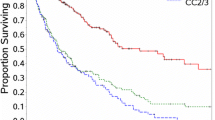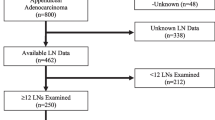Abstract
Background
Survival in peritoneal dissemination from appendiceal cancer after complete cytoreductive surgery and hyperthermic intraperitoneal chemotherapy (CRS/HIPEC) varies within each histopathologic subtype. Analyzing patients with unique responses may uncover the mechanisms behind their extreme outcomes. We proposed a method to identify retrospectively and to characterize patients who responded exceptionally well or very poorly within each histopathologic subtype.
Methods
Retrospective review of patients with low-grade mucinous carcinoma peritonei (LGMCP), high-grade MCP (HGMCP), and HGMCP with signet ring cells (HGMCP-S) with complete CRS/HIPEC (CC-0/1) was performed. Patients were divided by recurrence status. Median follow-up was calculated for each. Exceptional responders (ExR) were defined as alive without recurrence after median follow-up of the nonrecurrent group. Poor responders (PoR) were defined as disease recurrence before median follow-up of the recurrent group. Perioperative characteristics were analyzed.
Results
LGMCP, HGMCP, and HGMCP-S had 48 (41%), 19 (23%), and 7 (14%) ExR and 11 (10%), 20 (24%), and 20 (39%) PoR, respectively. All ExR had lower median PCI (26 vs. 36 [p = 0.004]; 13 vs. 33.5 [p < 0.001]; 3 vs. 29.5 [p = 0.001]). Fewer LGMCP and HGMCP ExR had abnormal tumor markers (36% vs. 90% [p = 0.003]; 22% vs. 74% [p = 0.003]). More HGMCP and HGMCP-S ExR had CC-0 (vs. CC-1) cytoreductions (84% vs. 50%, p = 0.041; 100% vs. 40%, p = 0.008).
Conclusions
Stratifying patients by recurrence status and follow-up time successfully selects ExR and PoR within each histopathologic subtype. Perioperative characteristics of ExR versus PoR differ across histopathologic subtypes, except for disease burden. Genetic analysis may further elucidate differences and aid in the development of novel targeted therapies.



Similar content being viewed by others
References
Chua TC, Pelz JO, Kerscher A, Morris DL, Esquivel J. Critical analysis of 33 patients with peritoneal carcinomatosis secondary to colorectal and appendiceal signet ring cell carcinoma. Ann Surg Oncol. 2009;16(10):2765–70.
Sugarbaker PH, Jablonski KA. Prognostic features of 51 colorectal and 130 appendiceal cancer patients with peritoneal carcinomatosis treated by cytoreductive surgery and intraperitoneal chemotherapy. Ann Surg. 1995;221(2):124–32.
Alakus H, Babicky ML, Ghosh P, et al. Genome-wide mutational landscape of mucinous carcinomatosis peritonei of appendiceal origin. Genome Med. 2014;6(5):43.
Carr NJ, Bibeau F, Bradley RF, et al. The histopathological classification, diagnosis and differential diagnosis of mucinous appendiceal neoplasms, appendiceal adenocarcinomas and pseudomyxoma peritonei. Histopathology. 2017;71(6):847–58.
Misdraji J. Mucinous epithelial neoplasms of the appendix and pseudomyxoma peritonei. Mod Pathol. 2015;28(Suppl 1):S67–79.
Carr NJ, Cecil TD, Mohamed F, et al. A consensus for classification and pathologic reporting of pseudomyxoma peritonei and associated appendiceal neoplasia: the results of the Peritoneal Surface Oncology Group International (PSOGI) Modified Delphi Process. Am J Surg Pathol. 2016;40(1):14–26.
Sugarbaker PH. New standard of care for appendiceal epithelial neoplasms and pseudomyxoma peritonei syndrome? Lancet Oncol. 2006;7(1):69–76.
Jimenez W, Sardi A, Nieroda C, et al. Predictive and prognostic survival factors in peritoneal carcinomatosis from appendiceal cancer after cytoreductive surgery with hyperthermic intraperitoneal chemotherapy. Ann Surg Oncol. 2014;21(13):4218–25.
Reghunathan M, Kelly KJ, Valasek MA, Lowy AM, Baumgartner JM. Histologic predictors of recurrence in mucinous appendiceal tumors with peritoneal dissemination after HIPEC. Ann Surg Oncol. 2018;25(3):702–8.
Jacquet P, Sugarbaker PH. Clinical research methodologies in diagnosis and staging of patients with peritoneal carcinomatosis. Cancer Treat Res. 1996;82:359–74.
Shankar S, Ledakis P, El Halabi H, Gushchin V, Sardi A. Neoplasms of the appendix: current treatment guidelines. Hematol Oncol Clin N Am. 2012;26(6):1261–90.
Sugarbaker P. Technical handbook for the integration of cytoreductive surgery and perioperative intraperitoneal chemotherapy into the surgical management of gastrointestinal and gynecologic malignancy, 4th edn. Foundation for Applied Research in Gastrointestinal Oncology; 2005.
Clavien PA, Barkun J, de Oliveira ML, et al. The Clavien–Dindo classification of surgical complications: five-year experience. Ann Surg. 2009;250(2):187–96.
Aziz O, Jaradat I, Chakrabarty B, et al. Predicting survival after cytoreductive surgery and hyperthermic intraperitoneal chemotherapy for appendix adenocarcinoma. Dis Colon Rectum. 2018;61(7):795–802.
Sugarbaker PH. Epithelial appendiceal neoplasms. Cancer J. 2009;15(3):225–35.
Van Sweringen HL, Hanseman DJ, Ahmad SA, Edwards MJ, Sussman JJ. Predictors of survival in patients with high-grade peritoneal metastases undergoing cytoreductive surgery and hyperthermic intraperitoneal chemotherapy. Surgery. 2012;152(4):617–24 (discussion 624–5).
Esquivel J, Sugarbaker PH. Second-look surgery in patients with peritoneal dissemination from appendiceal malignancy: analysis of prognostic factors in 98 patients. Ann Surg. 2001;234(2):198–205.
Arjona-Sanchez A, Esquivel J, Glehen O, et al. A minimally invasive approach for peritonectomy procedures and hyperthermic intraperitoneal chemotherapy (HIPEC) in limited peritoneal carcinomatosis: the American Society of Peritoneal Surface Malignancies (ASPSM) multi-institution analysis. Surg Endosc. 2019;33(3):854–60.
Wagner PL, Austin F, Sathaiah M, et al. Significance of serum tumor marker levels in peritoneal carcinomatosis of appendiceal origin. Ann Surg Oncol. 2013;20(2):506–14.
van Ruth S, Hart AA, Bonfrer JM, Verwaal VJ, Zoetmulder FA Prognostic value of baseline and serial carcinoembryonic antigen and carbohydrate antigen measurements in patients with pseudomyxoma peritonei treated with cytoreduction and hyperthermic intraperitoneal chemotherapy. Ann Surg Oncol. 2002;9(10):961–67.
Taflampas P, Dayal S, Chandrakumaran K, Mohamed F, Cecil TD, Moran BJ. Pre-operative tumour marker status predicts recurrence and survival after complete cytoreduction and hyperthermic intraperitoneal chemotherapy for appendiceal Pseudomyxoma peritonei: analysis of 519 patients. Eur J Surg Oncol. 2014;40(5):515–20.
Chua TC, Moran BJ, Sugarbaker PH, et al. Early- and long-term outcome data of patients with pseudomyxoma peritonei from appendiceal origin treated by a strategy of cytoreductive surgery and hyperthermic intraperitoneal chemotherapy. J Clin Oncol. 2012;30(20):2449–56.
Omohwo C, Nieroda CA, Studeman KD, et al. Complete cytoreduction offers longterm survival in patients with peritoneal carcinomatosis from appendiceal tumors of unfavorable histology. J Am Coll Surg. 2009;209(3):308–12.
Votanopoulos KI, Russell G, Randle RW, Shen P, Stewart JH, Levine EA. Peritoneal surface disease (PSD) from appendiceal cancer treated with cytoreductive surgery (CRS) and hyperthermic intraperitoneal chemotherapy (HIPEC): overview of 481 cases. Ann Surg Oncol. 2015;22(4):1274–9.
Glehen O, Mohamed F, Sugarbaker PH. Incomplete cytoreduction in 174 patients with peritoneal carcinomatosis from appendiceal malignancy. Ann Surg. 2004;240(2):278–85.
Halabi HE, Gushchin V, Francis J, et al. Prognostic significance of lymph node metastases in patients with high-grade appendiceal cancer. Ann Surg Oncol. 2012;19(1):122–5.
Baumgartner JM, Tobin L, Heavey SF, Kelly KJ, Roeland EJ, Lowy AM. Predictors of progression in high-grade appendiceal or colorectal peritoneal carcinomatosis after cytoreductive surgery and hyperthermic intraperitoneal chemotherapy. Ann Surg Oncol. 2015;22(5):1716–21.
Ang CS-P, Shen JP, Hardy-Abeloos CJ, et al. Genomic landscape of appendiceal neoplasms. JCO Precis Oncol. 2018(2):1–18.
Hara K, Saito T, Hayashi T, et al. A mutation spectrum that includes GNAS, KRAS and TP53 may be shared by mucinous neoplasms of the appendix. Pathol Res Pract. 2015;211(9):657–64.
NCI. Molecular profiling in tissue samples from patients with cancer who are exceptional responders to treatment. 2014. https://ClinicalTrials.gov/show/NCT02243592. Accessed 25 Jan 2019.
The ASCO Post. Unraveling the Mystery of What Gives Exceptional Responders Their Superpower. http://www.ascopost.com/issues/august-25-2018/unraveling-the-mystery-of-what-gives-exceptional-responders-their-superpower/. Accessed 29 Jan 2019 (2018).
Borazanci E, Millis SZ, Kimbrough J, Doll N, Von Hoff D, Ramanathan RK. Potential actionable targets in appendiceal cancer detected by immunohistochemistry, fluorescent in situ hybridization, and mutational analysis. J Gastrointest Oncol. 2017;8(1):164–72.
Ihemelandu C, Sugarbaker PH. Clinicopathologic and prognostic features in patients with peritoneal metastasis from mucinous adenocarcinoma, adenocarcinoma with signet ring cells, and adenocarcinoid of the appendix treated with cytoreductive surgery and perioperative intraperitoneal chemotherapy. Ann Surg Oncol. 2016;23(5):1474–80.
Smeenk RM, Verwaal VJ, Antonini N, Zoetmulder FA. Survival analysis of pseudomyxoma peritonei patients treated by cytoreductive surgery and hyperthermic intraperitoneal chemotherapy. Ann Surg. 2007;245(1):104–9.
Baratti D, Kusamura S, Nonaka D, et al. Pseudomyxoma peritonei: clinical pathological and biological prognostic factors in patients treated with cytoreductive surgery and hyperthermic intraperitoneal chemotherapy (HIPEC). Ann Surg Oncol. 2008;15(2):526–34.
Acknowledgment
The authors thank Roy Hatch for his help with the literature review.
Author information
Authors and Affiliations
Corresponding author
Ethics declarations
Disclosure
The authors declare that there is no conflict of interest regarding the publication of this paper.
Additional information
Publisher's Note
Springer Nature remains neutral with regard to jurisdictional claims in published maps and institutional affiliations.
Rights and permissions
About this article
Cite this article
Munoz-Zuluaga, C., King, M.C., Sardi, A. et al. Selection and Characteristics of Patients with Peritoneal Dissemination from Appendiceal Cancer with Exceptional/Poor Survival After CRS/HIPEC. Ann Surg Oncol 26, 2268–2275 (2019). https://doi.org/10.1245/s10434-019-07374-z
Received:
Published:
Issue Date:
DOI: https://doi.org/10.1245/s10434-019-07374-z




